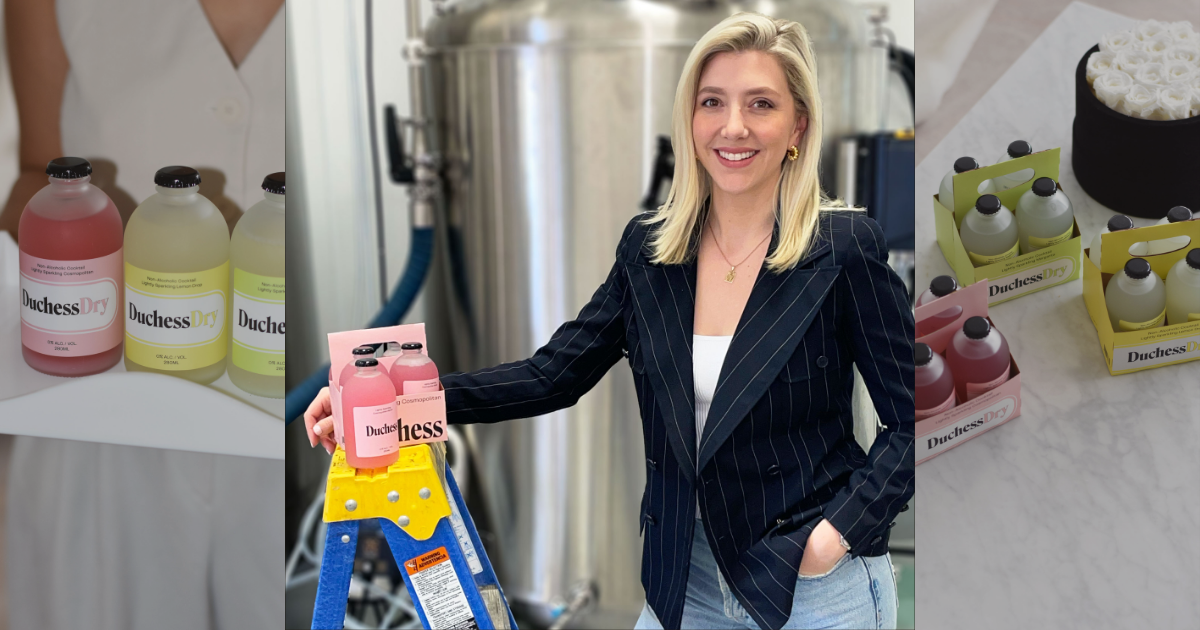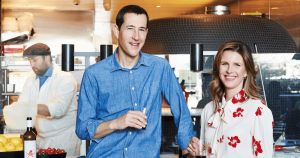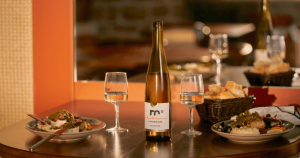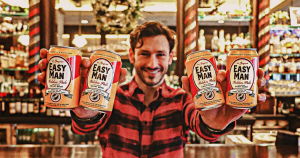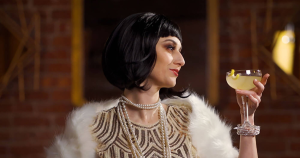In this interview, Olivia Lovenmark-Hay shares her journey from launching lower ABV cocktails to introducing Duchess Dry, a line of non-alcoholic options. Olivia discusses the unique market opportunities she identified, the importance of high-quality ingredients, and the significant reception her brand has received.
Olivia also delves into the strategic decisions behind Duchess’s alcohol content, the innovative formulation process for her non-alcoholic line, and her plans for expansion into the US market. This conversation highlights Olivia’s deep understanding of her demographic and her commitment to providing exceptional drinking experiences, both alcoholic and non-alcoholic.
Dry Atlas: Olivia, you’ve taken an interesting path to the non-alcoholic cocktail space. Duchess Cocktails first launched with relatively low ABV ready-to-serve options. More recently, you introduced Duchess Dry as an extension of your brand. First, can you talk about your decision to venture into lower ABV cocktails back when alcohol moderation wasn’t as popular as it is today?
Olivia Lovenmark-Hay: When I looked at the market, I realized there wasn’t something that would serve me as a consumer. In 2019, when my idea first came about, all I saw was the 7% ABV ready-to-drink. There were only a few brands on the shelf in Canada, where I’m based. Those products were generally made with artificial flavors and packaged in a can. They just didn’t provide the kind of experience that I sought as an alcohol drinker seeking high quality options.
I align very closely with Duchess’s demographic. If I’m going to have a drink, it needs to be a good drink. The pre-mixed cocktail market at the time did not serve that desire at all. Not to mention that the beverage marketing felt quite kitschy and didn’t suit me. I never saw anything that I would want to post on Instagram or share on TikTok. I saw a significant opportunity there.
When we did our research, it showed that the market was going in the premium direction. I knew there would be interest in something that was higher quality than what was on the market. It gave me a lot of courage and conviction to deliver a quality experience: real juice, really top-notch packaging, something aesthetically pleasing that would be gorgeous to share on your Instagram.
That’s what led me to start Duchess. Across Canada, we were pioneers in the ready-to-serve space. RTD existed. For us, glass bottles were really important—consumers can simply pour them into a martini glass or another beautiful piece of glassware. That wasn’t available then. I knew that’s how I wanted to enjoy a drink, and I thought that’s how my demographic would want to enjoy a drink.
DA: How cool, to create a product essentially for yourself. You approach your brand with such a deep understanding of the demographic. I’m curious, for your alcoholic SKUs, why the decision to go relatively low ABV as opposed to full-strength?
OL: We knew that, when entering the alcohol market and introducing an unfamiliar product, we couldn’t go too alcoholic. In RTD, they were used to 5% or 6% ABV, being able to crush two or three cans and not get too drunk. Even at 12% ABV, we’re still educating people. We have to say, “Hey, it’s exactly the same as wine. It’s not crazy. It’s just different from what you’re expecting.”
The other piece is on the business side. In Canada, we have a tiered taxation system when it comes to alcoho. Around 13% or 14% ABV, we saw opportunity. Above that 14% ABV, you’re in spirit taxation. Farther below is the typical RTD. Most people would go into the RTD taxation category because it’s way cheaper. We actually pay quite a lot more tax at 12%, but it opened up an opportunity because people weren’t playing in that space. It presented a gap to be filled.
DA: How was the initial reception for your alcoholic SKUs?
OL: The reception was pretty incredible right out of the gate. We launched in December of 2020 after a year and a half of formulation and organizing our production. And we launched on Instagram first as an ecomm-forward brand.
We sold out the first run within a few days. We’d been told by the co-packer that we were working with at the time, “You know, it could take you six months to sell your first run.” That was about five or six thousand bottles, which seemed enormous at the time! It was kind of daunting to think about selling through. But we put ads up on Instagram—that was the first and only time we’ve ever actually done paid marketing. We put these ads up, we built a waitlist, we did pre-orders. Within three days, all of it was gone. The reception was fantastic. What was really, really validating was that it was exactly the customer we’d thought it would be.
It was those women between 30 and 60 with a sweet spot in the late 30s to 40s. They just gravitated to it. It was like cult love level. It was incredible to see. These were wine drinkers. They were looking for a cocktail alternative to wine, but hadn’t found one. Duchess was clearly for them. And they continue to love it. It’s been incredible to see that growth and to connect with those women.
DA: When you launched, did you know you’d ultimately introduce 0% ABV options as well?
OL: At first, we had no intentions of going into the non-alcoholic space. It wasn’t part of our vision—it didn’t even occur to us at that point. By January of 2023, seeing all the non-alc options hitting the market, we started to get serious about it. We thought, “Okay, there’s room for something better in the market,” frankly. A lot of what we were seeing in the mocktail space was essentially juice and soda or artificial flavoring and soda. It just didn’t do it for me. I wasn’t looking for a soda alternative. I was looking for a cocktail alternative.
Come March of 2023, we started working on our formulations. If there was anyone who could do this, I knew we could do it well. We’ve historically been good at building a solid product. So, we set out to create non-alcoholic cocktails that actually taste like you’re drinking a Cosmo, a lemon drop, a tequila-based margarita. It took about ten months in formulation. Coincidentally, I got pregnant, and I ended up testing way more non-alc than I ever expected to. It really cemented our conviction in doing something that actually tasted like a cocktail. Now, when we do tastings, we serve our alcoholic SKUs and our non-alcoholic ones side by side. Many can’t tell the difference. We’re really proud of the formulation that we’ve come up with.
DA: Wow, ten months to formulate. What challenges did you encounter? You deal with all of these fresh, natural ingredients versus artificial ones. That must present some difficulties on the production side of things, not to mention perfecting the taste profile.
OL: The time-consuming thing was cracking how to emulate the mouthfeel and flavor profile of alcohol. I don’t think I quite appreciated the complexity that even a vodka brings to a drink now. If you look at the alcohol that’s used in commercial beverages, there’s definitely a scale. There are those that partner with like a bottle or a brand name for a higher end, more expensive product. With Duchess, we use a commercial-grade vodka—but we use a top-tier one. It has a lot of body. It adds a lot to the flavor.
When we made our non-alc Cosmo, for example, we took out the vodka. It was a lot more thin and it didn’t have the same sort of bite. It took a lot of time to replicate that mouthfeel and that flavor profile with natural ingredients. We really try not to go chemical-forward and we really avoid that chemical taste, that aluminum, tinny taste that a lot of products with artificial flavorings have. We developed a lot of custom-made ingredients to get us to where we are. That’s ultimately what took us the most time.
DA: Did you ever consider functional ingredients to produce a buzzed feeling? Or were you always focused on creating a beautiful, taste-forward product?
OL: Definitely the latter. One thing we learned about the beverage space, whether alcoholic or non-alcoholic, is that simplicity is key. When you have too many marketing messages, they get lost. I think it’s best to focus on one or two key messages about your product. That helps consumers understand who you are and how they can relate to your brand.
Functional beverages can be a tricky space. We’re seeing examples of that happening in the US right now. A couple of “better-for-you” sodas are having to remove gut benefit claims from their marketing because it’s been shown that they’re not quite true.
Our focus was 110% on: let’s nail being as clean as possible with a top-tier flavor profile. We didn’t even look for alternatives on the sugar side. We don’t favor stevia or artificial sweeteners. We use raw, regular sugar because we want the full flavor to be there. But we try to go as low sugar as possible to keep the profile tart. Overall, we’re really trying to be as clean as possible in our ingredients.
DA: I love to see your embrace of real sugar. Why did you not shy away from it as many non-alc brands do?
OL: There are two aspects to it. First, if you’re going to have a drink, have a good one. We’re not encouraging people to drink a four-pack in one sitting. Regardless of whether it contains chemical-based sugar, a sugar alternative, or raw sugar, you’re still ingesting something. Sugar has negative qualities, but so do sugar alternatives and chemicals. As a brand owner, it’s about choosing what’s going to make the best experience for your consumer.
Second, we use real juice. You’ll see sediment in the bottles. We consider that a marketing feature. We could use chemicals as suspension agents, but we choose not to because we try to do things as cleanly as possible.
DA: Tell us a bit more about the Duchess Dry line. How has the reception been? Where do you think you’ll take that line in the future?
OL: Duchess Dry is a collection of three flavors that emulate our three most popular alcohol cocktails: our Cosmo, Lemon Drop, and Margarita. We launched our Cosmo and Lemon Drop at the end of 2023, and just launched our Margarita in February. Duchess Dry is quite new to the market, but the growth rate has surpassed the growth rate of our alcoholic business.
While alcohol is still at higher volume, the growth rate is really, really strong. We’re now working on volume. We started the brand out by getting into liquor stores and specialty stores, and it’s now going into grocery. We’ll roll out in grocers across Canada, with the US next on our roadmap.
DA: If that growth rate continues to be so strong, do you think you’d ever focus more on the Dry line? Or is alcoholic ready-to-serve the heart of what you do? How are you thinking about the future of Duchess overall?
OL: I think they’re equally important, the two of them. I’m really excited to represent what I perceive as an underrepresented population in the alcohol space. So many of the products that have been oriented towards female drinkers have just been so sweet. That’s not what we really want. I’m proud to be offering something that’s different to a demographic that I think was underserved.
Alcohol feels still quite behind in terms of being forward thinking or innovative. There is still so much room for disruption in alcohol in Canada, certainly, and in the US. I think Duchess on the alcohol side has a lot of room to grow and we’re really excited for that. For me, it’s equal. The adoption is easier sometimes on the non-alcoholic side, because the trend is there, but the opportunity is still massive on the alcohol side.
DA: Let’s take a step back now. Before Duchess, you were a marketer. So, today, you bring a fresh marketing lens to Duchess. You’re also the co-founder of a marketing tech platform called Repose. Can you share more about Repose, how it ties to what you’re doing at Duchess, and how it’s influencing how you’re building your community on the DTC side?
OL: Repose is a gated community platform where brands and creators can create their own private clubs, free or paid, in order to have a private space to nurture their super fans. It arose from a personal unmet marketing need.
I self-funded the Duchess brand, and we’ve been bootstrapped since then—no external capital. We’ve had to be really careful and scrappy with every dollar. I didn’t have a lot of money to put into paid growth marketing. I’m not against paid, but I can be a little skeptical about centering your marketing efforts solely on a paid growth strategy. Because, once the paid part goes away, you can lose that funnel. You can attract a lot of people, but there might be a lot of one-time buyers.
I was really focused on building a foundation of dedicated community members who would come back to Duchess—three times, four times, five times, 11 times. We see customers now coming back into their 15th order in the past nine months. We really wanted to focus on them, but there was no community platform that really suited us at Duchess. We started building a community solution for Duchess. Now, that’s turned into something that is suitable for other brands. They can now provide a digital experience that really does suit their demographic.
With our dedicated Duchess community, I can segment our best customers and superfans and share exclusive benefits with them. They’re the first to know when we have a new flavor coming or a limited-edition flavor like our Espresso Martini. I’ll do AMAs and give them that behind the scenes look at our brand. That’s special to them. I feel like I’m friends with them now! Actually, a woman from our digital community stopped me in Zara the other day, “It’s so nice to meet you in person. I feel like I know you from the live stream that you did.” Repose has been a great tool for us, and it’s helped us really cement our community.
DA: That’s so interesting! Now, back to Duchess. Whether you’re talking alcoholic or Dry, are you more focused on DTC, retail, or on premise?
OL: All of the above. We want to make it as easy as possible to get Duchess. We love ecomm. The margins are better for us, and consumers get full access to our entire collection. Not every store is going to have the entire suite of products on shelf. With our delivery service, it’s next day in many cases, or two or three days delivery. It goes right to your door and it’s so convenient.
But, when it comes down to it, both alcoholic and non-alcoholic beverages are largely discovered on the shelf. That’s the number one way people hear about our brand. It’s really important from a marketing perspective, as well, to have that on-shelf visibility. From a business perspective, our biggest driver of revenue is the wholesale side of our business.
Hospitality has been slightly less of a priority than wholesale. It’s lower sell-through rates than you’re getting in store. We view them as fantastic marketing partnerships, like what we’re doing with the Rosewood Hotel here in Vancouver. They have our non-alcoholic cocktails in all of their suites. Those are the kind of partners that we love working with.
DA: You hinted a bit at the US. Since most of our Dry Atlas readers are US-based, can you talk more about your plans for international expansion?
OL: Actually, as we speak, we’re working with some partners on getting into the Pacific Northwest. That’s where we’ll start—just make sure we get a good feel for what the market looks and feels like, and that we’ve got everything sort of buttoned up. From there, we’ll be looking at California. That’s where we will start on the West Coast, first with the alcohol side first. That’s coming in 2024.
Then, the non-alcohol side will follow shortly thereafter. We’re just getting our bearings in grocery right now. Within the last half of the year, I could see us getting into some chains. We’ll see. But it’s all very much in the works.
Dry Atlas is a media company focused on alcohol alternatives. We deliver non-alcoholic beverage news, insights, and recs to over five million people annually. To stay up to date on all things non-alc, subscribe to our weekly newsletter.


